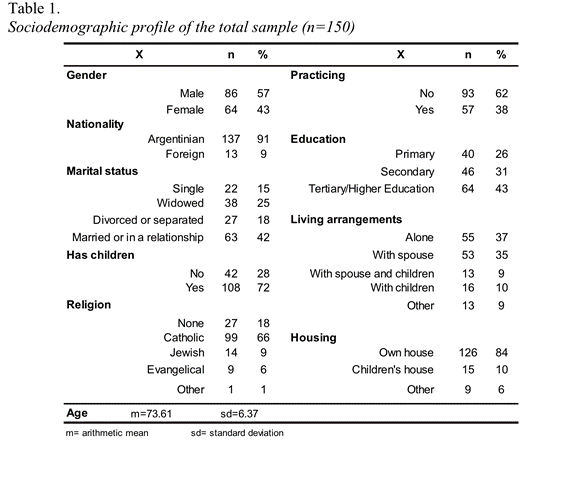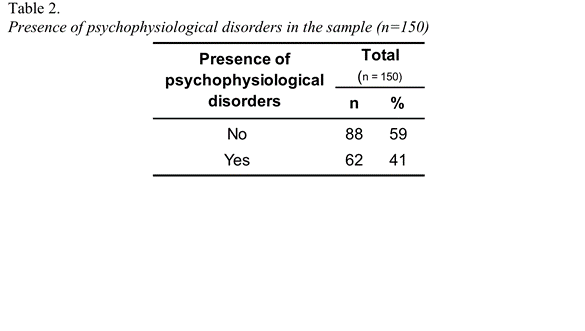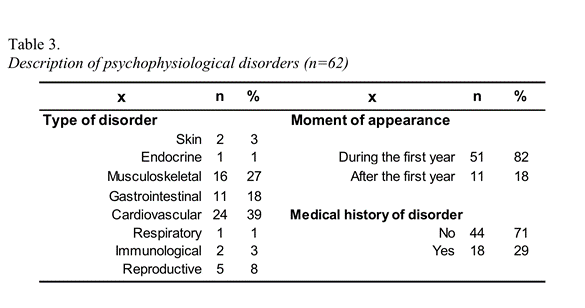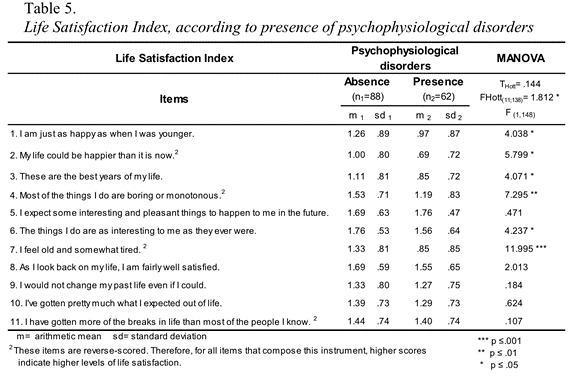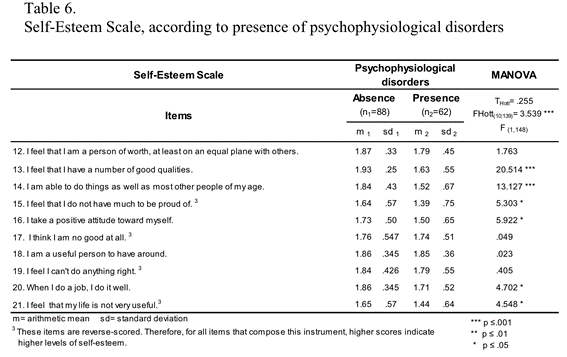Serviços Personalizados
Journal
Artigo
Links relacionados
Compartilhar
Ciencias Psicológicas
versão impressa ISSN 1688-4094versão On-line ISSN 1688-4221
Cienc. Psicol. vol.11 no.2 Montevideo nov. 2017
https://doi.org/10.22235/cp.v11i2.1498
Original Articles
Retirement, psychophysiological disorders and psychological well-being in a sample of Argentinian older adults
1,Instituto de Investigaciones Cardiológicas, Universidad de Buenos Aires. Argentina
2Instituto de Neurociencia Buenos Aires. Argentina
3Servicio de Neurología Cognitiva, Neuropsicología y Neuropsiquiatría, Fundación para la Lucha contra las Enfermedades Neurológicas de la Infancia.Argentina
1, , , Consejo Nacional de Investigaciones Científicas y Técnicas. Argentina paulahermida@conicet.gov.ar florenciatartaglini@conicet.gov.ar cfeldberg@hotmail.com dstefani@fmed.uba.ar
Abstract: The purpose of this study was to describe the relationship between psychophysiological disorders and psychological well-being during retirement in a group of Argentinian older adults. An ex post facto simple retrospective design was used. 150 older adults (self-sufficient, mixed-gender, of middle socioeconomic status, with stable and formal employment prior to retirement) answered a Socio-Demographic and Retirement Profile Background Questionnaire, a Health Status Questionnaire and the Psychological General Well-Being Index. The results show greater psychological well-being amongst those who presented less psychophysiological disorders related to retirement. These findings coincide with previous research and highlight the importance of studies on psychological well-being as a central aspect in older adult quality of life
Key Words: older adults; retirement; psychological well-being; psychophysiological disorders; aging
Resumen: El objetivo de este estudio fue describir la relación entre trastornos psicofisiológicos y bienestar psicológico en la jubilación, en un grupo de adultos mayores argentinos. Se utilizó un diseño de estudio “ex post facto”, de carácter retrospectivo, simple. 150 adultos mayores (autoválidos, de nivel socioeconómico medio y diferente género, residentes en Buenos Aires y zonas de influencia -Argentina-, y que poseían un vínculo laboral estable y formal antes de jubilarse) respondieron un Cuestionario de datos sociodemográficos y de perfil jubilatorio, un Cuestionario de estado de salud y el Índice de Bienestar Psicológico. Los resultados mostraron un mayor bienestar psicológico entre quienes informaron una menor presencia de trastornos psicofisiológicos asociados a la jubilación. Dichos hallazgos coincidieron con los de investigaciones previas destacando la importancia del estudio del bienestar psicológico como un aspecto central en la calidad de vida de los adultos mayores
Palabras clave: adultos mayores; jubilación; bienestar psicológico; trastornos psicofisiológicos; envejecimiento
Introduction
Retirement is the stage in life in which subjects stop working. It should be observed that working implies an activity in a specific context, which can have different meanings to the subject, while at the same time it constitutes a social phenomenon in which the subject structures his/her identity through the relationships established with other individuals (Dessors & Guiho-Bailly, 1998; Peiró& Prieto, 1996; Schvarstein & Leopold, 2005). Therefore, not working due to retirement implies abandoning a work role developed throughout adult life, and the need to structure a new role (Biancotti et al., 2001; Téllez Rivera & Reyes Montoya, 2004).
In Western societies it is considered, arbitrarily, that the age between 60 and 65, age in which people stop working and retire, is the beginning of old age. Regarding this stage in life, different concepts have been developed. While in the early XXth century a deficit model prevailed, one in which old age was associated with sickness, ugliness and death, nowadays a model more associated with development predominates (Stefani, 2000). In this respect, Baltes, Reese and Lipsitt (1980) argue that life-span development is constant and that different variables intervene: normative (related to age-graded biological and social factors), contextual (related to the historical moment in which the individual is immersed) and non-normative (related to the individual’s own history or life experience, i.e. psychological variables). Therefore, it is considered that in old age motor, cognitive and emotional variables intervene, but there are also interindividual psychological differences due to age and related to the context or setting in which the individual lives (Birren, 1996; Fernandez-Ballesteros 2007).
In this line of thought, one of the factors that can have a positive or negative impact in adapting to old age is psychological well-being (Lawton, 1991). This concept has been addressed by different authors, resulting in multiple definitions. In all of them, the existence of two major components can be observed: an emotional or affective one, linked to feelings of pleasure and displeasure experimented by the individual, and a cognitive one, related to how the individual evaluates his life experience (Villar, Triadó, Solé Resano,& Osuna, 2003). Neugarten, Havighurst and Tobin (1961) define it as the feeling of well-being that derives from the level of satisfaction the older adult has about himself and his life. Then, according to the authors, life satisfaction as a construct that reflects individual psychological well-being and allows assessment is composed of five aspects: “zest for life”, “resolution and fortitude”, “congruence between desired and achieved goals”, “high self-concept” and “optimistic mood tone”. Under this theoretical framework they developed the Life Satisfaction Index version-A (Neugarten, Havighurst & Tobin, 1961). In subsequent studies, such as Zegers Prado, Rojas-Barahona and Förster Marín (2009), it was observed that the “resolution and fortitude” aspect was not correctly assessed by the instrument, and neither was the “high self-concept” aspect. That is why the Rosenberg Self-Esteem Scale is also frequently used to evaluate life satisfaction (Rojas-Barahona, Zegers, & Föster, 2008; Stefani, 2002). This concept is defined by Rosenberg (1965) as an attitude towards the self, favorable or unfavorable, resulting from an evaluation about the individual’s own characteristics.
In recent years, the study of psychological well-being in older adults through the concept of life satisfaction has become important as it is considered a health indicator, from an evolved point of view that integrates different aspects of health and sickness (Castillo-Carniglia, Albala, Dangour, & Uauy, 2012). Regarding this aspect, Mroczek and Kolarz (1998) had already observed that the global measure of well-being is stable in time, making it an interesting indicator since it doesn’t present substantial modifications linked to changes associated with age. This does not imply that all older adults have high levels of psychological well-being, since that depends on different variables or factors. In this regard, Maddox (1964) already claimed that social activity or participation conditions psychological well-being.
On the other hand, it has been observed that individuals that present a higher psychological well-being adapt better and deal more successfully with the tension generated by different stressors (Figueroa, Contini, Lacunza, Levín, & Estévez, 2005; Jiménez, Izal & Montorio, 2016). Psychological stress is a process in which an individual going through changes in life feels threatened by them, if he considers that they exceed his ability to cope with the new situation (Lazarus & Folkman, 1984). Moreover, it has been shown that stressful situations trigger a physiological response (Cano Vindel & Miguel Tobal, 2000; Casado Morales, 1996). From this angle, the concept of psychophysiological disorders includes those physical alterations that are provoked, worsened or perpetuated by psychosocial factors (Cano Vindel & Miguel Tobal, 2000; Gatchel & Bianchard 1993). In this line of thought, it was observed that social situations perceived as stressful can generate negative emotions and, consequently, the appearance or worsening of diseases such as respiratory, cardiovascular or immunological ones. (Cockerham, 2013; Piqueras Rodríguez, Ramos Linares, Martínez González, & Oblitas Guadalupe, 2009; Wheaton, 1996). In that respect, several investigations have concluded that retirement is one of the main stressful life events that can generate important changes in a person’s health (Behncke, 2012; Holmes & Rahe,1967; Jafri et al., 2017).
This article aims to describe the presence of psychophysiological disorders related to retirement and the levels of well-being in a group of retired Argentinian older adults, and to analyze the potential link between the two variables.
Methods and Materials
Research design
We followed steps corresponding to an ex post facto simple retrospective design (Montero & León, 2002).
Participants
An intentional, non-probabilistic sampling strategy was used on older adults attending adult day-care centers and workshops reporting to the Government of the City of Buenos Aires and of Greater Buenos Aires (Argentine Republic). A snowball effect was also used.
The sample was comprised of 150 mixed-gender, self-sufficient older adults over 60 years old, of middle socioeconomic status, residing in a major urban center (Autonomous City of Buenos Aires and Greater Buenos Aires, Argentine Republic), with stable and formal employment prior to retirement.
In table 1 we can find the arithmetic means, standard deviations and frequency and percentage counts, according to the level of measurement, of socioeconomic profile characteristics of the total sample. According to the summarized version of the Gino Germani Social and Economic Status Index, (Grimson et. al., 1972), in the answers older adults gave on education and occupation it is observed that all sample subjects have a middle socioeconomic status.
As for the profile of retirees in the sample, average retirement age is 65.29 years old (sd=4.86 years), and average time spent in retirement is 9.31 years (sd= 5.57). As for occupation prior to retirement, they declare being “employees” (26%) “independent professional/businessman” (22%) or having engaged in “several trades” (23%), and having worked in said activities for “over 15 years” (91%).
Instruments
- Socio-Demographic Background and Retirement Profile Questionnaire. An ad hoc questionnaire was designed, with 12 open and closed questions with fixed alternatives, to obtain information on socio-demographic characteristics (gender, age, nationality, marital status, level of educational attainment, prior occupation, housing, children and religious affiliation) and retirement characteristics (retirement age, time spent in retirement, number of years spent working in prior occupation).
- Health Status Questionnaire. To find out more about the presence of psychophysiological disorders related to retirement, an ad hoc questionnaire was designed consisting of 5 closed questions with fixed alternatives, evaluating if the subjects perceived any changes in their health related to retirement. In case of affirmative answers, disorders were classified according to their type: skin, urinary, endocrine, musculoskeletal, gastrointestinal, cardiovascular, respiratory, immunological and reproductive (Ortego, López, Alvarez & Aparicio, 2012), the moment of appearance and the existence of a medical history linked to development of disorder.
- Index of Psychological Well-Being. This technique was selected with the purpose of estimating retiree’s assessment of his/her life and himself/herself in general. The Index was structured by Stefani (2002), using version-A of the Life Satisfaction Index by Neugarten, Havighurst and Tobin (1961), adapted locally by Eva Muchinik (1984). The Index consists of 11 items that clearly define three of the five dimensions proposed by Neugarten: “zest for life”, “congruence between desired and achieved goals” and “optimistic mood tone”. The Bachman & O’Malley version for older adults - RSE-B - (1977) of the Rosenberg Self-Esteem Scale (1965) was also included, consisting of 10 items.
Therefore, the Index of Psychological Well-Being consists of 21 items: 13 direct statements -positively oriented- (items 1, 3, 5, 6, 8, 9, 10, 12, 13, 14, 16, 18 and 20) and 8 reversed statements -negatively oriented- (items 2, 4, 7, 11, 15, 17, 19 y 21). When administering the questionnaire, subjects were asked to score them according to their level of agreement through a 3-point Likert scale: “disagree”, “undecided” and “agree”. Positive statements were assigned a value of 2 for “agree”, 1 for “undecided”, and 0 for “disagree”. Negative statements were assigned a reversed value: 0 for “agree”, 1 for “undecided” and 2 for “disagree”.
The total score, as well as the score for each sub-scale (Life Satisfaction Index and Self-Esteem Scale), is obtained by calculating the average values assigned to each answer. In this way, the subject is placed in a 0-2 continuum, where a low score indicates, respectively, low levels of psychological well-being, low life satisfaction or negative self-esteem, and a high score indicates high levels of psychological well-being, high life satisfaction or positive self-esteem. This instrument was adapted to the local medium, obtaining results that indicate it has adequate psychometric qualities for this type of study: Cronbach’s a=0.75 (Stefani, 2002); it was also chosen because it is easy to administer and to evaluate.
Procedure
Steps were taken to obtain authorization to interview older adults attending day-care centers and workshops reporting to the Government of the City of Buenos Aires and other areas of influence. A copy of the research project along with the informed consent was sent to the authorities of these institutions. Once the corresponding permits were obtained, the evaluation protocol was administered to older adults through an individual interview lasting approximately 40 minutes.
Statistical analysis
Percentages, arithmetic mean and standard deviation were calculated to describe study variables, according to their level of measurement.
According to the presence/absence of psychophysiological disorders related to retirement, a comparison was established between: a) total average score in the Index of Psychological Well-Being and its components (Life Satisfaction and Self-Esteem), by calculating the arithmetic mean, standard deviation and Student’s t-test, and b) the scores the subjects chose for items in the Life Satisfaction Index and Self-Esteem Scale, respectively, through multivariate analysis of variance.
Results
Psychophysiological Disorders
Table 2 and 3 show calculated frequencies and percentages of psychophysiological disorders present in the sample. There we find that 59% of the sample did not report the presence of a psychophysiological disorder. In turn, those that reported new psychophysiological disorders related to retirement, said that 39% were “cardiovascular” and 27% were “musculoskeletal”, and that 82% of them took place “during the first year” of retirement and 71% occurred without a previous medical history of the disorder.
Psychological Well-being
Arithmetic means and standard deviations were calculated for the sample of total scores obtained in the Psychological Well-Being Index and its subscales. The total sample exhibited a psychological well-being average score (m=1.52; sd=.32), that is reflected in life satisfaction (m=1.33; sd=.39) and positive self-esteem (m=1.73; sd=.33), indicating a favorable trend.
Psychological Well-being according to psychophysiological disorders
Table 4 presents means and standard deviations of total scores in the Psychological Well-Being Index for those who expressed absence or presence of psychophysiological disorders, as well as the results of the Student’s t-test to compare both groups. In global terms, we can observe (considering all index items and their respective subscales) a statistically significant difference for psychological well-being (t (148)= 3.462; p=.001), indicating that those that did not develop psychophysiological disorders present, with a higher probability, higher scores of psychological well-being than those who got sick (m 1 =1.60 sd 1 =.30 vs. m 2 =1.42 sd 2 =.34).
Table 4: Psychological well-being and its components, according to presence of psychophysiological disorder
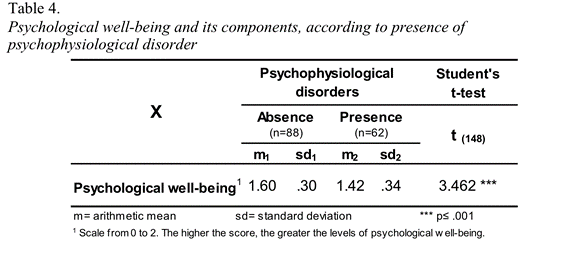
Tables 5 and 6 show the means and standard deviations of scores obtained in the Life Satisfaction Index and the Self-Esteem Scale respectively, for subgroups conformed by those who stated either absence or presence of psychophysiological disorders. Also, each table displays the results of the multivariate analysis of variance (MANOVA), considering the items that make up these questionnaires both as a whole and separately.
Regarding the first analysis in MANOVA, results indicate a significantly different pattern of responses in the Life Satisfaction Index and the Self-Esteem Scale according to absence or presence of psychophysiological disorders (Life satisfaction: THott=.144; FHott(11;138)=1.812; p=.05; Self-Esteem: THott=.255; FHott(10;139)=3.539; p=.000). Therefore, said MANOVA analysis confirms results previously obtained regarding the Psychological Well-Being Index, in that those interviewees that stated not having developed psychophysiological disorders related to retirement scored higher in life satisfaction and self-esteem.
When considering each item separately, resulting “F” values in MANOVA show a pattern where the means in the group that did not present psychophysiological disorders are generally higher than those in the group that did present psychophysiological disorders. Also, statistically significant differences can be observed in some items of the Life Satisfaction Index (Table 5: in 6 out of 11 items) and of the Self-Esteem Scale (Table 6: in 6 out of 10 items), which would explain the global differences described before.
As can be observed in table 5, older adults that reported an absence of psychophysiological disorders tend to present higher scores in life satisfaction, compared to those who reported a presence of psychophysiological disorders; they state to a greater degree not feeling old and tired (m 1 =1.33 vs. m 2 =.85), not feeling that what they do is so boring or monotonous (m 1 =1.53 vs. m 2 =1.19), feeling as happy as when they were young (m 1 =1.26 vs. m 2 =.97), not feeling that their life could be happier than what it is now (m 1 =1.00 vs. m 2 =.69), feeling that these are the best years of their life (m 1 =1.11 vs. m 2 =.85), and feeling that the things they do are as important as they ever were (m 1 =1.76 vs. m 2 =1.56).
In addition, table 6 indicates that those older adults that did not develop psychophysiological disorders, compared to those who did, generally tend to obtain higher self-esteem scores, reporting a belief that they: possess several positive qualities (m 1 =1.93 vs. m 2 =1.63), do things as well as most other people their age (m 1 =1.84 vs. m 2 =1.52), have a lot to be proud of (m 1 =1.64 vs. m 2 =1.39), show a more positive attitude towards themselves (m 1 =1.73 vs. m 2 =1.50), can do a job well (m 1 =1.86 vs. m 2 =1.71) and, lastly, that their life is useful (m 1 =1.65 vs. m 2 =1.44).
Discussion
The data obtained in the present study supports the proposed hypothesis that those who report a lower presence of psychophysiological disorders related to retirement will have a higher level of psychological well-being. Moreover, the relationship observed between life satisfaction and self-esteem and the development of diseases coincides with previous research. This research has found that a lower presence of physical discomfort was associated to higher life satisfaction (Castellano Fuentes, 2014) and self-esteem (Sánchez, Aparicio, & Dresh, 2006).
Regarding results obtained in psychological well-being for the total sample, high levels of life satisfaction and positive self-esteem were found. In this respect, in previous research conducted on samples with similar sociodemographic characteristics, it was observed that being married and a higher educational attainment level promote a rise in self-esteem (De León Ricardi, & García Méndez, 2016) and influence levels of life satisfaction (Zavala, Vidal, Castro, Quiroga, & Klassen, 2006). Previous research has also found that social support networks and high educational attainment levels promote well-being in older adults (Hertzog, Kramer, Wilson, & Lindenberger, 2009; Strout & Howard, 2012).
On the other hand, although the majority of the sample reported not having developed psychophysiological disorders related to retirement, those who did develop them reported no previous medical history of disorder and getting sick in the first year of retirement. These findings highlight the relevance of retirement as a stressful life event that impacts older adult health, and they coincide with Behncke’s research (2012), who observed that retirement heightens the odds of contracting several diseases.
In conclusion, the findings in this study generate empirical evidence on the role of psychological well-being as a key aspect in older adult quality of life. Just as the World Health Organization (2002) points out, there are several psychosocial factors when protecting older adult health which must be taken into account in the design of public policies and new lines of research. Therefore, psychological well-being could be a predictor variable for health and could protect against the negative effects of aging (Meléndez, Navarro, Oliver & Tomás, 2009; Ortiz & Castro, 2009; Ostir, Markides, Black, & Goodwin, 2000; Vecina, 2006). In this respect, we highlight the importance of generating retirement preparation programs, in order to attenuate the impact of the event and the consequences it could have on people’s health, promoting well-being and, consequently, fostering healthy aging (Hernández Triana, 2014; Limón Mendizábal, 1993).
Finally, this study has some limitations that have to be pointed out, such as the impossibility to generalize results due to the type of sample used, aside from the limitations inherent in such an approach. In addition to the aforementioned limitations, the population studied has a middle socioeconomic status, and it would be important to be able to include, in future studies, different socioeconomic and educational backgrounds, preserving population representativeness.
Referencias
Bachman, J.G. & O’Malley, P.M. (1977). Self-esteem in young men: a longitudinal analysis of the impact of educational and occupational attainment. Journal of Personality and Social Psychology, 35, 365-380. doi: http://dx.doi.org/10.1037/0022-3514.35.6.365 [ Links ]
Baltes, P.B, Reese, H.W. & Lipsitt, L.P. (1980). Life-span developmental psychology. Annual Review of Psychology, 31, 65-110. [ Links ]
Behncke, S. (2012). Does retirement trigger ill health. Health Econ., 21, 282-300. doi: http://dx.doi.org/10.1002/hec.1712 [ Links ]
Biancotti, C., Katz, M., Macotinsky, G., Malvicini, C., Mingorance, D., Paradelo, C. & Vazzano, L. (2001). Exclusión laboral y reorganización psíquica en el adulto mayor. Cuadernos de Gerontología: Asociación Gerontológica de Buenos Aires (AGEBA), 12(13), 69-73. [ Links ]
Birren, J. (1996). Encyclopedia of Gerontology: Age, Aging and the Aged. New York: Academic Press. [ Links ]
Cano Vindel, A. & Miguel Tobal, J.J. (2000, marzo).Emociones Negativas (Ansiedad, Depresión e Ira) y salud. Conferencia presentada en el I Congreso Virtual de Psiquiatría. [ Links ]
Casado Morales, M.I. (1996). Psicología y salud. Emociones y enfermedad: una relación compleja e indisoluble. Boletín de la Sociedad Española para el estudio de la ansiedad y el estrés, 5. Recuperado de http://www.ucm.es/info/seas/Boletine/boseas05.htm. [ Links ]
Castellano Fuentes, C.L. (2014). Análisis de la relación entre las actitudes hacia la vejez y el envejecimiento y los índices de bienestar en una muestra de personas mayores. Revista Española de Geriatría y Gerontología, 49(3), 108-114. doi: http://doi.org/10.1016/j.regg.2013.06.001 [ Links ]
Castillo-Carniglia, A., Albala, C., Dangour, A.D. & Uauy, R. (2012). Factores asociados a satisfacción vital en una cohorte de adultos mayores de Santiago, Chie. Gac.Sanit., 26(5), 414-420. doi: http://doi.org/10.1016/j.gaceta.2011.11.021 [ Links ]
Cockerham, W.C. (2013). Medical Sociology on the move. Springer: Netherlands. doi: https://doi.org/10.1007/978-94-007-6193-3 [ Links ]
De León Ricardi, C.A. & García Méndez, M. (2016). Escala de Rosenberg en Población de Adultos Mayores. Ciencias Psicológicas, 10(2), 119-127. doi: http://doi.org/10.22235/cp.v10i2.1245 [ Links ]
Dessors, D. & Guiho-Bailly, M-P. (Comps.) (1998). Organización del trabajo y salud: de la psicopatología a la psicodinámica del trabajo. Buenos Aires: Lumen/Hvmanitas [ Links ]
Fernandez-Ballesteros, R. (2007). GeroPsychology. European perspectives for an aging world. Gottingën: Hogrefe. [ Links ]
Figueroa, M. I., Contini, N., Lacunza, A., Levín, M. & Estévez, A. (2005). Las estrategias de afrontamiento y su relación con el nivel de bienestar psicológico. Un estudio con adolescentes de nivel socioeconómico bajo de Tucumán, Argentina. Anales de Psicología, 21(1), 66-72. [ Links ]
Gatchel, R. J. & Bianchard, E. (1993). Psychophysiological disorders: Research and clinical applications. Washington: American Psychological Association. doi: http://dx.doi.org/10.1037/10142-000 [ Links ]
Hernández Triana, M. (2014). Envejecimiento. Rev Cubana Salud Pública. 40(4), 361-78. Recuperado de http://scieloprueba.sld.cu/scielo.php?script=sci_arttext&pid=S0864-34662014000400011&lng=es. [ Links ]
Hertzog, C., Kramer, A.F., Wilson, R.S. & Lindenberger, U. (2009). Enrichment Effects on Adult Cognitive Development: Can the Functional Capacity of Older Adults Be Preserved and Enhanced?. Psych Sci Public Interest, 9(1), 1-65. doi: http://dx.doi.org/10.1111/j.1539-6053.2009.01034.x [ Links ]
Holmes, T.H. & Rahe, R.H. (1967). The social readjustment rating scale. Journal of Psychosomatic Research, 11, 213-218. doi: https://doi.org/10.1016/0022-3999(67)90010-4 [ Links ]
Jafri, S.H.R, Ali, F. Mollaeian, A., Hasan, S.M., Hussain, R., Akkanti, B.H., … El-Osta, H.E. (2017). Major stressful life events and risk of developing lung cancer. Journal of Clinical Oncology 35 (15), 1575. doi: http://dx.doi.org/10.1200/JCO.2017.35.15_suppl.1575 [ Links ]
Jiménez, M.G., Izal, M. & Montorio, I. (2016). Programa para la mejora del bienestar de las personas mayores. Estudio piloto basado en la psicología positiva. Suma Psicológica, 23(1), 51-59. doi: https://doi.org/10.1016/j.sumpsi.2016.03.001 [ Links ]
Lawton, M.P. (1991). A Multidimensional View of Quality of Life in Frail Elders. In: J.E. Birren, J. Lubben, J. Rowe, D. Deutchman (Eds)., The Concept and Measurement of Quality of Life (pp. 3-27). New York, Academic Press. doi: https://doi.org/10.1016/b978-0-12-101275-5.50005-3 [ Links ]
Lazarus, R.S. & Folkman, S. (1984). Stress, appraisal and coping. New York: Springer. [ Links ]
Limón Mendizábal, M. R. (1993). La preparación a la jubilación: nueva ocupación del tiempo. Revista Complutense de Educación, 4(1), 53-67. [ Links ]
Maddox, G. (1964). Disengagement theory: A critical evaluation. Gerontologist, 4, 80-2. doi: https://doi.org/10.1093/geront/4.2_Part_1.80 [ Links ]
Melendez, J.C., Navarro, E., Oliver, A. & Tomás, J.M. (2009). La satisfacción vital en los mayores. Factores sociodemográficos. Boletín de Psicología, 95, 29-42. [ Links ]
Montero, I. & León, O.G. (2002). Sistema de clasificación del método en los informes de investigación en Psicología. Revista Internacional de Psicología Clínica y Salud, 2(3), 115-127. [ Links ]
Mroczek,D.K & Kolarz, C.M. (1998). The effect of age on positive and negative affect: A developmental perspective on happiness. Journal of Personality and Social Psychology , 75, 1333-1349. doi: https://doi.org/10.1037//0022-3514.75.5.1333 [ Links ]
Muchnik, E.G. de (1984). Hacia una nueva imagen de la vejez. Buenos Aires: Editorial de Belgrano. [ Links ]
Neugarten, B. L., Havighurst, R. J. & Tobin, S. S. (1961). The measurement of Life Satisfaction. Journal of Gerontology, 16, 134-143. doi: https://doi.org/10.1093/geronj/16.2.134 [ Links ]
Organización Mundial de la Salud (2002). Definición y evaluación de los riesgos para la salud. En: Informe sobre la Salud en el Mundo (pp. 9-29). Recuperado de http://www.who.int/whr/2002/en/2002fliersesp.pdf [ Links ]
Ortego M.C., López S., Álvarez M.L. & Aparicio MM. (2011). Trastornos psicofisiológicos. En: Ciencias Psicosociales II, Universidad de Cantabria. Recuperado de https://ocw.unican.es/pluginfile.php/1575/course/section/2034/tema-09.pdf [ Links ]
Ortiz, J., & Castro, S. (2009). El bienestar psicológico de los adultos mayores y su relación con el autoestima y la autoeficacia. Ciencia y Enfermería, 15(1), 25-31. doi: https://doi.org/10.4067/s0717-95532009000100004 [ Links ]
Ostir, G. V., Markides, K. S., Black, S. A. & Goodwin, J. S. (2000). Emotional well-being predicts subsequent functional independence and survival. Journal of the American Geriatrics Society, 48, 473-478. doi: https://doi.org/10.1111/j.1532-5415.2000.tb04991.x [ Links ]
Peiró, J. M. & Prieto, F. (1996). Tratado de Psicología del Trabajo: Aspectos Psicosociales del Trabajo (vol I & II). Madrid: Síntesis. [ Links ]
Piqueras Rodríguez, J. A., Ramos Linares, V., Martínez González, A. E. & Oblitas Guadalupe, L. A. (2009). Emociones negativas y su impacto en la salud mental y física. Suma Psicológica , 16(2), 85-112. [ Links ]
Rojas-Barahona, C.A., Zegers, B., Förster, C.E. (2008). La escala de autoestima de Rosenberg: Validación para Chile en una muestra de jóvenes adultos, adultos y adultos mayores. Rev Med Chile, 137, 791-800. [ Links ]
Rosenberg, M. (1965). Society and the adolescent self image. Princeton: Princeton University Press. [ Links ]
Sánchez M., Aparicio M. & Dresh V. (2006). Ansiedad, Autoestima y Satisfacción autopercibida como predictores de la Salud, diferencias entre hombre y mujeres. Psicothema, 18(3), 584-590. [ Links ]
Schvarstein, L. & Leopold, L. (Eds.) (2005): Trabajo y subjetividad. Buenos Aires: Paidós. [ Links ]
Stefani, D. (2000). Prejuicios hacia la vejez: Una forma de violencia social. Revista del Instituto de Investigaciones en Psicología de la Facultad de Psicología, 5(2), 115-124. [ Links ]
Stefani, D. (2002). El efecto de las creencias acerca del sentido de la vida en la participación social del senescente. (Tesis doctoral inédita). Facultad de Medicina, Universidad de Buenos Aires. Argentina. [ Links ]
Strout, K.A. & Howard, E.P. (2012). The six dimensions of wellness and cognition in aging adults. J Holist Nurs, 30(3),195-204. doi: http://dx.doi.org/10.1177/0898010112440883 [ Links ]
Téllez Rivera, V. & Reyes Montoya, D. (2004). Jubilación, envejecimiento y espacios alternativos de participación social. Rev. Santiago, 104, 102-105. [ Links ]
Vecina, M. L. (2006). Emociones positivas. Papeles del Psicólogo, 1, 9-17. [ Links ]
Villar, F., Triadó, C., Solé Resano, C. & Osuna, M.J. (2003). Bienestar, adaptación y envejecimiento: cuando la estabilidad significa cambio. Rev Mult Gerontol, 13(3), 152-162. [ Links ]
Wheaton, B. (1996). The domains and boundaires of stress concepts. En H.B. Kaplan (Ed.), Psychosocial stress (pp. 29-70). San Diego, CA: Academic Press. [ Links ]
Zavala, M., Vidal, D., Castro, M., Quiroga, P. & Klassen, G. (2006). Funcionamiento social del adulto mayor. Ciencia y enfermería, 12(2), 53-62. doi: https://doi.org/10.4067/s0717-95532006000200007 [ Links ]
Zegers Prado, B., Rojas-Barahona, C. & Förster Marín, C. (2009). Validez y confiabilidad del Índice de Satisfacción Vital (LSI-A) de Neugarten, Havighurst & Tobin en una muestra de adultos mayores en Chile. Terapia Psicológica, 27(1), 15-26. doi: https://doi.org/10.4067/s0718-48082009000100002 [ Links ]
Received: July 07, 2017; Revised: August 29, 2017; Accepted: October 03, 2017











 texto em
texto em 

